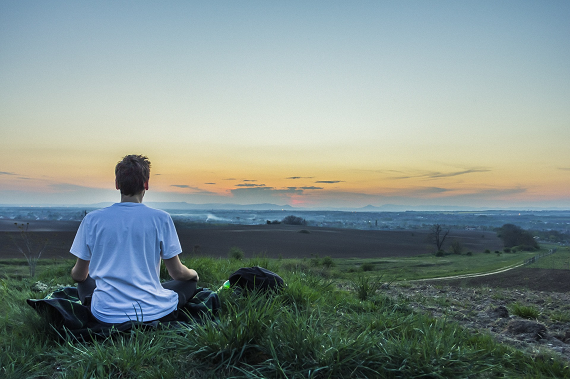How to use guided mindfulness meditations wisely
Guided meditations, particularly online (it used to be Tapes or CDs back when I started) are common ways for people to start learning meditation because they are easily accessible and time-wise, easy to fit into the daily routine. They are a good starting point for many.
However, I’ve noticed they have a downside. People can become dependent on them to meditate. This isn’t healthy, so in this blog, we are going to explore this topic and how to develop a more healthy independent meditation practice.

What is a dependency cycle?
Firstly, it is useful to understand what a dependency cycle is in terms of everyday life habits. Knowing how they take place can be the first step in “decluttering” your mind of them, and as it is such a big topic, I’ve written a separate blog on them called Dependency cycles and decluttering the mind: a reflection.
OK, so in case you haven’t read the blog to sum it up: one can be constantly trying to fill up space in one’s life. This can be in the form of constantly doing something throughout the day: work, listening to music, endless entertainment, family, friends, TV; there can never be a quiet moment.
One becomes dependent on this noise and this can reflect internally as well, thoughts cycling over and no feeling of space or clarity internally. One can become dependent on the internal chatter, seeing this as the norm; however, one can also have an intuition that perhaps this isn’t healthy. This is often why people turn to meditation apps or guidance, to help them find some space and clarity amongst the endless cycle of thoughts.
It is understandable.
Guided meditations for decluttering
Guidance on slowing down to find some space can be very beneficial; particularly good for newcomers to meditation. A problem can occur when that guided meditation becomes “yet another object” to fill up space. I’ve seen it happen. Before we go into this, here is a great article called: The Promises and Perils of Guided Meditation.
A real-life example or two
A friend of mine I knew learnt meditation via a well-known app and then going to some courses. Three years later she was still using the well-known app (not mine might I add) and said she needed it to meditate. I said to her 'try and do one day with it and one day without for a while and then go for a week without it.' However, she reported back she just couldn’t do it, that was the last I heard of how she was doing.
I’m going to hazard a guess as to what happened. The meditation apps helped her focus and learn some basic techniques of mindfulness: stay with the breath, observe feelings of the body sitting, recognise thoughts coming and going. All good stuff.
However, she seemed to have become dependent on the guiding voice the app offered, so the underlying attachments (they feed on objects – usually interesting) were never really allowed to surface and burn off (bit by bit in reality) to reveal the calm that lies beneath.
Not enough space
Perhaps the guided meditation went something like:
“Sit with the breath”
“Let thoughts go”
“Notice your posture”
“Come back to your breath”
“Let thoughts go”
“Let...”
Fifteen-minutes went, guidance over.
No space within that time to sit in the silence.
So, what is the solution? No guidance at all, just sit there silently? Well, I’ve also seen the other extreme of someone doing meditation entirely by themselves (one guy went for 5 years) and going in the wrong direction with it all. The five-year chap in question had become quite deluded thinking he was a great meditator (he was ever so withdrawn and not at ease). He’d turned up to a centre and was chatting to others; I did say to him guidance was useful in stopping one deluding themselves – I couldn’t resist having a poke to see what would happen! He did respond actually and considered getting some guidance.
Guidance can be useful (in the right dosage)
So, yes after twenty-years I still have the humility to go for bits of guidance now and again. One Sunday a month I usually go and do a guided meditation via some monks I know. Once a year I go on retreats with them. It is healthy to have reminders.
Other than that I sit silently each day just doing the meditation unguided.
And yes, in the beginning, I had a lot more guidance: going to classes weekly, doing some CD guidance (pre-app days), but I also used to sit quietly by myself.
The benefits of just sitting quietly
I just had to sit unguided on many occasions back in my early days. In hindsight that was a healthy way to learn. Some guidance, some non-guidance, so that is what I’m going to recommend. Here are three approaches, choose the one that suits you right now and be willing to mix and change it as and when:
Day by Day
If you are a complete beginner eight weeks of regular daily guidance can be useful. Try five days when you listen to guidance via apps when you are practising and then two days when you just sit quietly. Do try and get some input from an experienced teacher as well. After eight weeks look to cut the day to day guidance down to say two days with and five days without for another period.
Week by Week
This is a good approach if you have an actual teacher or if you have been meditating for some time. Go once a week to the guided meditation and then for the other six days try and do some meditation by yourself. Be ready for some difficulties while sitting like restlessness and unease to arise. Learn to sit with these and allow them to pass; this is a key skill to learn in becoming a strong meditator.
Month by Month
This is really for someone who has been through the above and meditation has become part of their life. This involves meditating most days by oneself, no guidance at all just sitting. Then once a month going for some guidance from another meditator. The other meditator doesn’t necessarily have to be more experience, just that another voice and point of view can be useful; simply take what you will from them.
Year by Year
This should be mixed with the month by month approach. It is useful for a regular meditator to go on retreat. Avoid the idea that “I’m awakened and I can now just kick back” this is a delusion if you were awakened you take great pleasure in going on retreats and have the humility to listen to others. Anyway, going on a guided retreat once a year can be a great way to freshen up one’s practice, find out where there are any holes and continue one’s learning of meditation.
I appreciate this is one point of view so check out The Unbearable Irony of Meditation Apps he makes some good points from his experience. Might I add that at Establish Mindfulness we have avoided some of the questionable practices he points out; we like to leave users to come and go, learning in their own time – just saying.
We also have unguided meditations - just a starting and finishing bell - littered around every category to help learners get used to meditating by themselves. Here is one if you like to try it for ten minutes:
Your experiences
What are your experiences with this? Have you found you’ve become dependent on the very thing you where using to find that space away from dependency? If so I’d love to hear from you.
Signing out.

